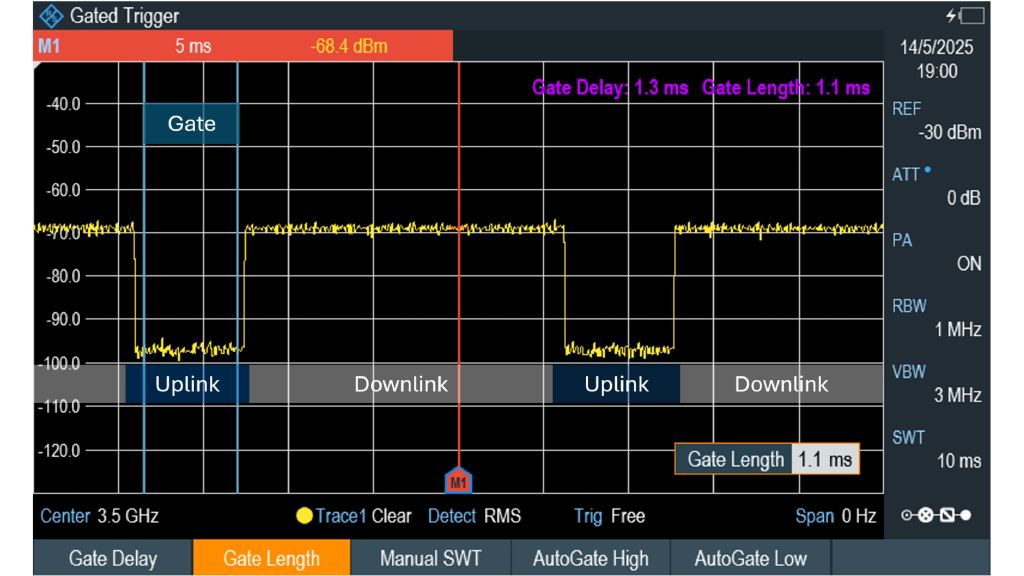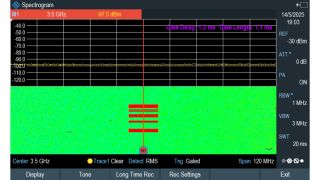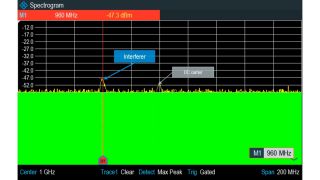

Small form factor with a huge gain in performance: The R&S®Spectrum Rider FPH and directional antenna help identify and locate interferers, even in time division duplex (TDD) networks.
Your task
As 5G has grown in popularity, keeping the spectrum clean has posed new challenges for network operators. Whether gaming applications, quick downloads of movies or sharing presentations over a conferencing platform, high-speed data transfers, ultra-low latency and ultra-high reliability are expected. Maximizing spectral efficiency and cost competition are driving the wireless market.


5G NR TDD signal taken in frequency domain using an R&S®Spectrum Rider FPH, captured from a replicated N78 band with a 3.5 GHz center frequency, 100 MHz bandwidth and 30 kHz subcarrier spacing.
TDD technology comes into play when spectrum is shared between downlink (DL) and uplink (UL) within the same channel or band of interest as defined by the 3rd Generation Partnership Project (3GPP). Even if TDD is not new to the wireless world, its implementation creates new challenges, specially when detecting interference with a conventional spectrum analyzer.


Typical configurations of FDD signal (left) and TDD signal (right)
Communications UL is more susceptible to interference than DL. Concentrating on the frequency range allocated to UL is easy. In frequency division duplex (FDD) networks and the interference source can be identified and located with a spectrum analyzer or portable receiver. In TDD networks, the DL and UL use the same frequency and DL signals mask the UL and any other signals.


Gated trigger in zero span mode: TDD slots are visible and a gate can be configured on a UL slot to trigger the spectrum measurements
Rohde & Schwarz solution
Handheld solutions from Rohde & Schwarz, such as the R&S®Spectrum Rider FPH handheld spectrum analyzer, support a gated trigger that lets users separate UL and DL signals in the time domain.


R&S®Spectrum Rider FPH using the gated trigger feature to separate UL from DL and clearly identify the intermittent interference signal (see the spectrogram).
The captured 5G NR (TDD) signal is constantly moving within the same band, which makes it difficult to separate UL from DL.
In time-domain measurements (zero span mode), UL and DL slots can be visualized. Users can configure a window or gate with a specific length. In this application users configure a gate that falls into a UL slot. The result is a convenient spectrum measurement of UL signals.


R&S®Spectrum Rider FPH displaying the interference in the UL signal
Identifying and locating interferers
The waterfall diagram supported by the R&S®Spectrum Rider FPH helps identify interference signals. The long-time recording of up to 999 h is practical for identifying sporadic interferers. Signals can be recorded during specific user-configured time windows or for specific signal limits.
The R&S®Spectrum Rider FPH features a tone function that helps in the interference hunting process. Users can look for the signal with a directional antenna by listening to the instrument tone. The higher the power of the interferer, the higher-pitched the sound on the instrument.
Interference hunting in 5G NR TDD networks, a task that looked impossible at the beginning, is now easy with the handheld solutions from Rohde & Schwarz.


Supported analyzers, antennas and accessories






